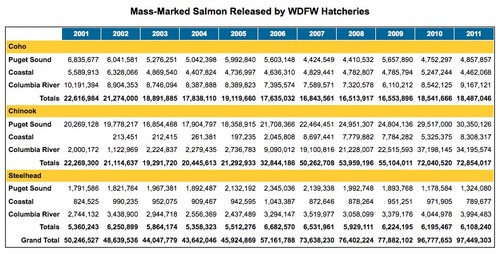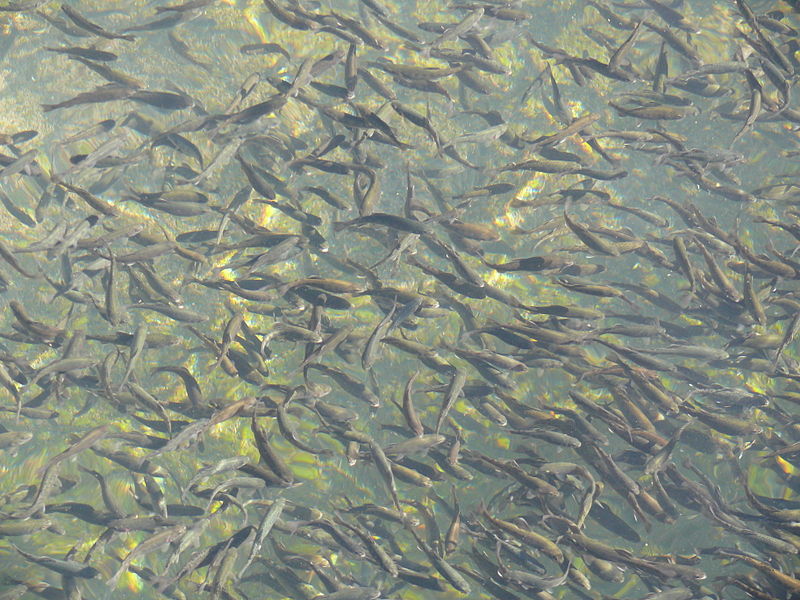
As a result of some recent successful litigation on the Sandy, a threatened lawsuit on Puget Sound, and three proposed wild steelhead gene banks, pro hatchery advocates are crying foul. While their rhetoric runs the spectrum, the basic premise is that wild fish groups want to take away all their farm raised hatchery fish.
Spend some time surfing those group's websites and Facebook pages and you'd think the hatchery sky is falling..... nothing could be further from the truth. There's even a new movie and petition sponsored by some of these groups driving the pro-hatchery cause.
Lets take a quick look at what state and federal taxpayers have contributed to support their beloved Washington hatchery programs.

The Washington hatchery system represents a public investment of over $1-billion.
The Washington Department of Fish and Wildlife (WDFW) operates 83 hatcheries of which 75 - 80% are dedicated to producing salmon or steelhead. There are an additional fifty-one tribal hatcheries and 12 federal hatcheries contributing to the statewide salmon harvest. By my count that's 146 hatcheries, god forbid you give up one.... or two.
From 2011 - 2013 The WDFW Hatcheries Division had a total operating budget of $63.9-million, including $11.1-million from the State General Fund.
In 2012, the Washington State Legislature provided an additional investment of $56.7-million in capital funds for statewide hatchery infrastructure improvements.
How's your local school department budget faring these days?

WDFW salmon hatchery releases almost doubled in 10 years, increasing from 50 million in 2001, to over 97 million in 2011 ...... those wild fish groups sure have been taking a bite out of those hatchery programs.
It is absurd to suggest that Washington's hatchery programs are under threat when almost twice the number of hatchery fish are being released into the wild than in 2001.
So how about our neighbor to the south?
In 2012 the Oregon Department of Fish and Wildlife operated 32 hatcheries, 6 rearing ponds, 14 acclimation facilities, and 12 adult trapping facilities.
Funding for the operation of these facilities comes from a variety of sources: 12 are federally funded, 8 are state funded, and 12 are funded by a combination of state and federal funds.
Annual operating costs for these facilities amounted to approximately $25.0 million in 2012, of which $16.8 million was provided by federal agencies, $2.2 million came from state general funds, and $6.0 million came from other sources, including license fees, power producers and water users such as the City of Portland and Portland General Electric.
 A total of 42.7 million hatchery fish were released into the waters of Oregon. Of these releases, approximately 37.2 million are anadromous fish and 5.4 million are resident fish. So despite having approximately one fifth the number of hatcheries as Washington, Oregon plants 50% of the number of fish. Those wild fish loving libertatds sure are doing a pretty poor job of dismantling Oregon's hatchery welfare state.
A total of 42.7 million hatchery fish were released into the waters of Oregon. Of these releases, approximately 37.2 million are anadromous fish and 5.4 million are resident fish. So despite having approximately one fifth the number of hatcheries as Washington, Oregon plants 50% of the number of fish. Those wild fish loving libertatds sure are doing a pretty poor job of dismantling Oregon's hatchery welfare state.
Despite what the pro hatchery/wild groups would like you to believe, the numbers show they have been the beneficiary of considerable state and federal hatchery welfare resources to the detriment of wild fish stocks. It's unfortunate that it took litigation to tip the balance ever so slightly back towards a focus on wild fish.
 Wednesday, July 2, 2014 at 12:00AM
Wednesday, July 2, 2014 at 12:00AM  Photo:Peter Potrowl
Photo:Peter Potrowl El Guapo |
El Guapo |  3 Comments |
3 Comments |  Au Sable,
Au Sable,  fish in the news,
fish in the news,  hatcheries suck in
hatcheries suck in  News,
News,  hatcheries
hatcheries 










